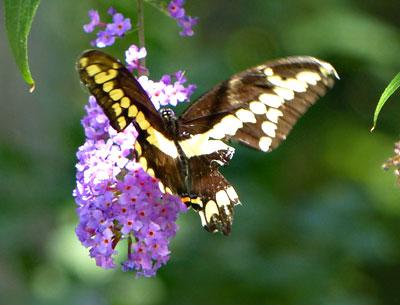Nature Notes: Butterfly Migration Begins

Most of September is summer, but in my eyes all of September is fall. Lots of wonderful things start happening at the end of August. The rich and the rowdy leave for the city. There is less traffic on the roads and highways. The days are cooler and the air less humid. Striped bass and neotropical warblers begin their fall migration southward. Snowy tree crickets and katydids sing the loudest. Asters and goldenrods break out in whites, blues, purples, and yellows. Beach plums ripen. Cranberries begin to ripen.
In September, Long Island, especially along the coast, is a great migration route for shorebirds, hawks, dragonflies, and butterflies, or at least one species of butterfly, the monarch. On Sunday Victoria Bustamante observed the 26th monarch of the year. (I’ve observed two, both on the same day.) It’s been looking glum in 2014, not only for monarchs, but for almost all butterflies. To date, I’ve seen two tiger swallowtails, one checkerspot, and, early in the spring, a single mourning cloak. Something is happening and we don’t know what it is, “Do you, Mr. Jones?”
Monday brought a ray of light. Victoria was at Jane Ross’s place on Georgica Pond checking on a tree. The yard was filled with flowers, and she encountered several monarchs. This is the time, the breezes were right — southwesterly — the sunshine was pleasant, the monarchs were on the wing, although lollygagging here and there to sip nectar. I won’t believe it until Sheila Small, who lives near Gurney’s Inn on the bluffs of Montauk, calls me and tells me that she is also noting monarchs passing in goodly numbers. Many of us know the sad story of how poorly last winter went in the monarch’s overwintering pine forests in the mountains of Mexico. Perhaps this year things will be better.
The monarch butterfly has only two real enemies, unfavorable climate and man and his agricultural pursuits. Long ago this amazing butterfly discovered that if it laid its eggs on members of milkweed family, all of which have a white sap containing poisonous cardenolides (the same giant steroid molecules found in foxglove, or digitalis), that it would do in almost all other insect larvae and, probably, you and I if we fed on them. The larvae don’t get their nutrition from these molecules, they tie them up in little packets that make them inedible when preyed upon. They are brightly colored, as are the red and black milkweed beetles that feed on the same host plants, advertising their noxiousness.
When they eventually morph into pupae, the poisons go with them. When the beautiful orange, yellow, and black imago adults emerge, they are equally poisonous. Again, those brilliant fall colors advertise their unpalatability. Just one taste is a lesson that lasts a lifetime for a would-be predator. Interestingly, the black-backed oriole and black-headed grosbeak that reside in their overwintering area are able to eat them without suffering greatly. One wonders if they, in turn, are protected from marauding hawks and other predators.
Way back in 1964, while a student at the University of California at Santa Barbara, I used to study the West Coast monarch, which is identical and thus far is faring much better than its Midwestern and East Coast brethren. I used to catch them in the fall when they were flying in a southeasterly direction along the coast to their winter grounds. Where, I never found out. They always flew against the wind. I learned to distinguish males with their distinct black markings, one per wing, from the females without them. I would catch them with a butterfly net, overnight them in the refrigerator, take them out in the morning, and note their bearings when they took off. Before lifting off they would pump their wings up and down several times to get their body temperatures up to takeoff temperature.
Five years prior to U.C.S.B., while at the Army Language School in Monterey, I lived in Pacific Grove, which abuts 17-Mile Drive and the Pebble Beach Golf Course. Its Monterey pines are famous for their large stash of overwintering monarchs. South of Pacific Grove is Pismo Beach, a spot frequently mentioned in jest by the late Bob Hope in his monologues. It’s just north and west of San Luis Obispo and is famous for its monarch butterfly grove, apparently the largest on the West Coast.
Another hopeful sign: A week ago while birding in Springs, Karen and Barbara Rubinstein observed a rare giant swallowtail butterfly. Barbara was able to snap a photo of it. I’m 78 and have never seen one.
Larry Penny can be reached via email at [email protected].
